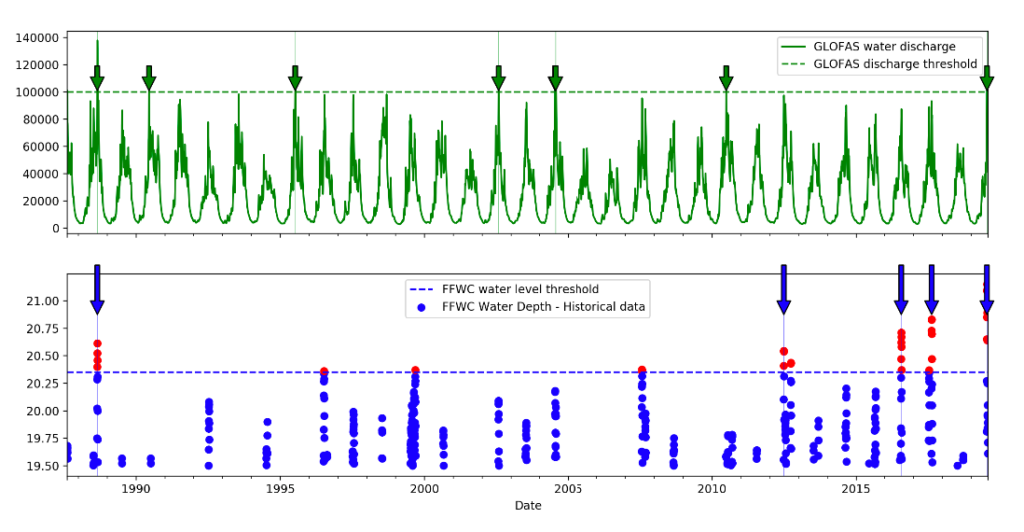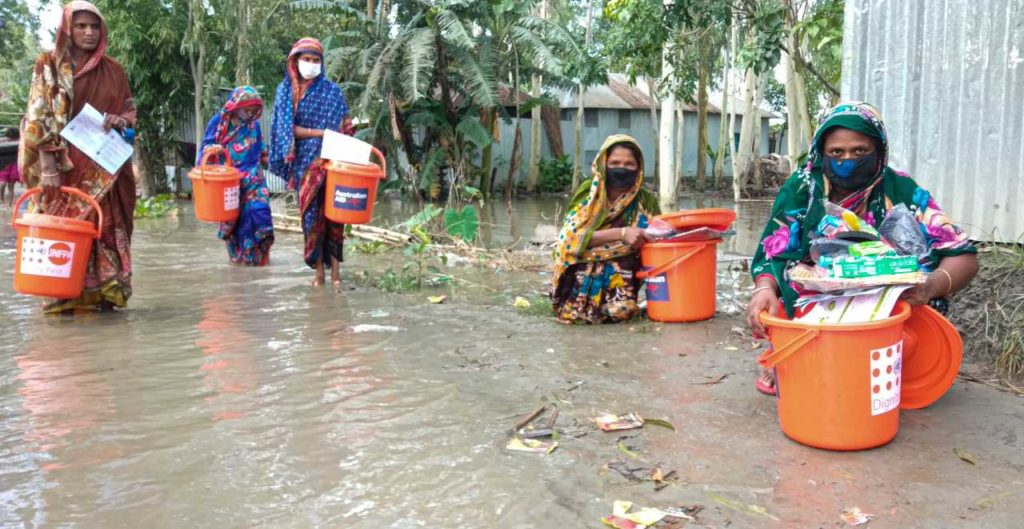Centre Service:
Predictive AnalyticsTags:
Summary:
Humanitarian response usually takes place after the impact of a crisis is visible. But in July 2020, with monsoon rains descending on Bangladesh, the Centre supported OCHA and partner organizations to act before disaster hit. Our predictive analytics team worked with colleagues from OCHA’s Humanitarian Financing Strategy and Analysis Unit (HFSAU), the International Federation of Red Cross and Red Crescent Societies (IFRC) and the Bangladesh Red Crescent Society (BDRCS) to develop and validate triggers to release funds for those likely to be worst affected by the floods.
On 4 July, the European Commission’s Global Flood Awareness System (GloFAS) predicted a high probability of severe flooding in Bangladesh. That threshold was the pre-activation trigger for the United Nations Central Emergency Response Fund (CERF) to release $5.2 million to the Food and Agriculture Organization (FAO), the World Food Programme (WFP) and the United Nations Population Fund (UNFPA). The funds would enable them to prepare to distribute assistance including cash, livestock feed, storage drums, and hygiene, dignity and health kits.
This was the fastest CERF allocation since its establishment in 2005 and the first one to take place before peak flooding, based on the available forecasts. Less than a week later, a separate activation trigger was reached and partners were able to deliver the much needed cash and supplies, ultimately reaching 200,000 people.
Challenge:
The Centre created its predictive analytics workstream in 2019 based on demand from OCHA’s leadership to “use data, and especially the tools of predictive analytics to get ahead, to be more anticipatory, to predict what is about to happen and to trigger the response earlier.” OCHA subsequently established anticipatory action frameworks in a number of high-risk countries that have three elements: a predictive model or forecast; pre-arranged financing based on triggers; and a pre-agreed action plan.
In February 2020, the United Nations Under-Secretary-General for Humanitarian Affairs and Emergency Relief Coordinator committed to investing up to $80 million from the CERF towards anticipatory action. This included over $5 million for Bangladesh, which is vulnerable to monsoon flooding every year from June to September, with approximately one quarter of the country inundated.
The Bangladesh pilot involved a two-step trigger system: a pre-activation trigger, based on the GloFAS forecast, and an activation trigger, based on the Government of Bangladesh’s Flood Forecasting and Warning Centre (FFWC) forecast. The Centre’s predictive analytics team was asked to provide technical support to analyze and validate the thresholds and triggers for the release of funds from the CERF.
Centre action:
The Centre team first performed a historical evaluation of both models by looking at data on flooding in the region since 1987 in order to understand how accurate the flood forecasts were. This involved comparing historical data against what the models were predicting at that time to see if the models were accurate, i.e., if the model correctly predicted an actual event as opposed to producing a false alarm. The team then produced estimates for the appropriate thresholds for the activation of the anticipatory action framework, so that the activation would only occur in events with a severe impact.
Given that it was a two-step activation process relying on two different models (GloFAS and FFWC), the team evaluated the models independently as well as in combination to assess their performance as a system. They specifically looked at how to optimize the strategy so that pre-activation (readiness) and activation (distribution of aid) were triggered in the same scenario. Teams from OCHA, IFRC, and BDRCS discussed the findings of this analysis and revised thresholds in the framework based on the Centre’s analysis and recommendations.

Outcome:
On 4 July, the GloFAS 10-day probabilistic forecast predicted that the areas targeted through the pilot, affecting one-third of the Jamuna River area’s total population, had a greater than 50 percent chance of facing a severe flood between 14 and 16 July. This activated the first step of the pilot, and CERF released $5.2 million to allow agencies to prepare.
Less than a week later, the Government’s FFWC predicted that the water level at Bahadurabad would cross the Government-defined “danger level” of +0.85 metres, thereby confirming the activation trigger and second step of the pilot. At this point, aid workers with FAO, WFP and UNFPA began distributing assistance based on the pre-agreed action plan.
The pilot is the first CERF activation of this kind in the humanitarian sector. The framework was set in motion through effective collaboration between technical and operational partners, demonstrating that predictive models can allow humanitarians to act early, before a shock, to mitigate and reduce impact.

Conclusion:
The Centre is participating in an independent evaluation as well as after-action learning reviews of the Bangladesh pilot. The assessment will capture feedback and provide insights into how best to deploy anticipatory action in the future. A final report will be made available in the coming months.
In addition to the work in Bangladesh, OCHA is also developing anticipatory action frameworks for food insecurity and drought in Somalia, Ethiopia, Chad, and Malawi, and for cholera in the Southern Africa region. The Centre will continue to provide technical support for model validation and trigger development to OCHA and our partners.
💸Cash transfers
🩸 Dignity kits
🌾Storage drums for seeds
People at risk in Bangladesh received crucial support before the beginning of the floods, thanks to @UNCERF anticipatory allocation➡️https://t.co/v6JKLopUZX#InvestInHumanitypic.twitter.com/iKuqQkfXos— UNCERF (@UNCERF) July 27, 2020
